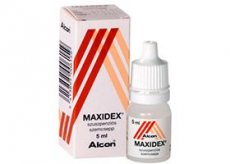Medical expert of the article
New publications
Preparations
Maxidex
Last reviewed: 03.07.2025

All iLive content is medically reviewed or fact checked to ensure as much factual accuracy as possible.
We have strict sourcing guidelines and only link to reputable media sites, academic research institutions and, whenever possible, medically peer reviewed studies. Note that the numbers in parentheses ([1], [2], etc.) are clickable links to these studies.
If you feel that any of our content is inaccurate, out-of-date, or otherwise questionable, please select it and press Ctrl + Enter.

Maxidex is a GCS used in ophthalmology. The drug has anti-inflammatory properties and is used locally.
Indications Maxidex
Indications include: treatment of steroid-sensitive allergic or inflammatory reactions (non-infectious) of the cornea, conjunctiva, and anterior segment of the eye. This category also includes inflammatory processes that develop after surgery.
Release form
Available as eye drops or ointment. Drops 0.1% in 5 ml dropper bottles. The package contains 1 bottle with the medicine. Ointment 0.1% in a 3.5 g tube. The package contains 1 tube with ointment.
Pharmacodynamics
Corticosteroids are very effective in eliminating inflammatory processes in the visual organs. They inhibit molecular adhesion to endothelial vascular cells, as well as cyclooxygenase I or II, and in addition, the process of cytokine secretion. This helps suppress the formation of inflammatory conductors and leukocyte adhesion to the vascular endothelium. As a result, these substances cannot penetrate into the inflamed eye tissue. Dexamethasone has powerful anti-inflammatory properties, as well as mineralocorticoid effects (reduced in comparison with other steroids) and is considered one of the most effective anti-inflammatory drugs.
Pharmacokinetics
Ophthalmic bioavailability of the active component after local use of the drug was studied in patients who had undergone cataract surgery. The peak level of the active substance in the intraocular fluid is approximately 30 ng/ml – it is reached 2 hours after application. Later, the concentration begins to decrease, and the half-life is 3 hours.
Dexamethasone is eliminated by metabolism. About 60% is excreted in the urine as 6-β-hydroxydexamethasone. No unchanged substance is detected in the urine. The plasma half-life is quite short – about 3-4 hours. The active substance binds to serum albumin at about 77-84%. The clearance rate is in the range of 0.111-0.225 l/h/kg, and the distribution volume is in the range of 0.576-1.15 l/kg. When dexamethasone is taken orally, its bioavailability is about 70%.
Dosing and administration
In case of acute or severe inflammation, it is necessary to drip 1-2 drops into the conjunctival eye sacs every half hour to an hour (initial stage of treatment). If this method has given a positive result, the frequency of the procedure is reduced - it should be carried out in the same dosage every 2-4 hours. Later, the dosage can be reduced to 1 drop 3-4 times a day (if this amount is sufficient to control the inflammatory process).
If there is no effect within 3-4 days of treatment, additional therapy (subconjunctival or systemic) may be prescribed.
In case of chronic inflammation, the dosage is 1-2 drops every 3-6 hours (or more often if necessary).
For mild inflammation or allergies, the dosage is 1-2 drops every 3-4 hours until the desired result is achieved.
Premature discontinuation of treatment is not recommended. Intraocular pressure should also be monitored at all times.
In case of combined administration with other drugs for local use, it is necessary to observe at least a 5-minute interval between procedures. In such cases, ointments are applied last.
Use Maxidex during pregnancy
Maxidex is prohibited for use during pregnancy.
Contraindications
Among the main contraindications to the use of drugs:
- individual intolerance to dexamethasone or other components of the drug;
- untreated acute bacterial infections;
- chickenpox, cowpox and other viral infections affecting the conjunctiva and cornea;
- development of fungal infections in the eye structures;
- mycobacterial form of eye infection;
- keratitis caused by herpes simplex.
Side effects Maxidex
Side effects of the drug include the following:
- nervous system organs – dysgeusia occasionally develops;
- ophthalmologic disorders – mainly the appearance of discomfort in the eyes; occasionally – conjunctivitis, keratitis, dry eye syndrome, development of photophobia, ocular itching, blurred vision, corneal staining, increased lacrimation, sensation of a foreign object in the eye, and also irritation, the appearance of scales on the edges of the eyelids and ocular hyperemia.
 [ 8 ]
[ 8 ]
Overdose
Not mentioned.
Storage conditions
The medicine (drops) should be kept strictly in an upright position, and the bottle should be tightly closed. Also, the drops are prohibited from freezing. Otherwise, the storage conditions are standard, both for the ointment and for the drops. Temperature - maximum 25 ° C.
 [ 12 ]
[ 12 ]
Shelf life
Maxidex can be used for 3 (drops) or 4 (ointment) years from the date of manufacture. After opening the bottle with drops, the medicine can be stored for no more than 4 weeks.
Attention!
To simplify the perception of information, this instruction for use of the drug "Maxidex" translated and presented in a special form on the basis of the official instructions for medical use of the drug. Before use read the annotation that came directly to medicines.
Description provided for informational purposes and is not a guide to self-healing. The need for this drug, the purpose of the treatment regimen, methods and dose of the drug is determined solely by the attending physician. Self-medication is dangerous for your health.

